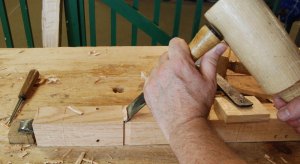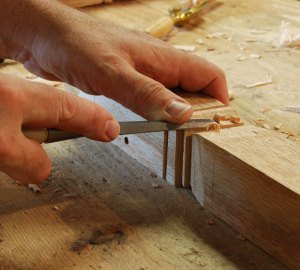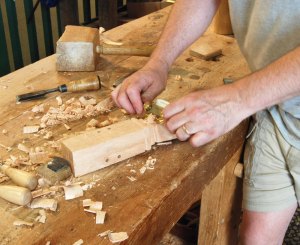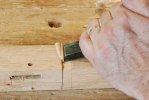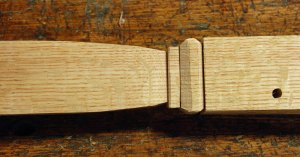
Before “Make a Joint Stool from a Tree” was a book, it was a workshop that Jennie Alexander and I taught a few times. The first session was 1991 at Drew Langsner’s Country Workshops. We had 12 students – several from the museum world, a few woodworkers and some innocent victims. Alexander and I used to duck out to the porch outside the shop and whisper, “What do we do next?” It was a free-for-all – especially when it came to the turned decoration on the stiles. A few students took the plunge and turned their stiles, a few made stopped chamfers and another batch made shaved “turned” decoration.
When we got around to actually finishing the book, I opted to use only the shaved/stopped chamfers as the “alternate” decoration for stiles. One of the reasons the book took us ages to complete is that we always tried to put everything we knew in it – so finally I left stuff out and got it done.
Today I made a sample stile with decoration that mimics or at least follows the turned patterns, but is cut using only a saw and some chisels. I used a spokeshave a bit, too. We find these forms from time to time on 17th-century examples, so if you’re ready to make a stool, and the turned work is intimidating, here’s a simple alternative.
I used a square and awl to line out the demarcations for the collar, bevel etc., then cut in with a backsaw at a few of these lines. You can use a marking gauge to help define the depth of these saw cuts. I started to, but then I just eyeballed it.
After making the saw cuts, the next step is to chop down to these kerfs with the chisel. Work alternately between bevel down, bevel up, hand-pressure and mallet work. I found it helpful on this, my-first-one-ever, to keep rotating the stile on the bench, working each face in succession. Must be from years of turning these things… .
The stile shown is a simple version, somewhat based on some northern Massachusetts chairs of the mid-17th century. I have seen more elaborate examples that have “coves,” “beads,” “collars” and more – just like turned work.
— Peter Follansbee
Editor’s note: Be sure to check out Peter’s blog for more on joint stools, 17th-century joinery and bird photography.
